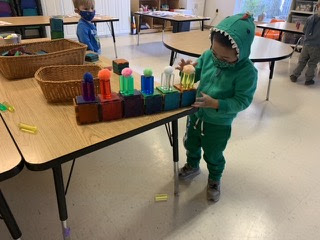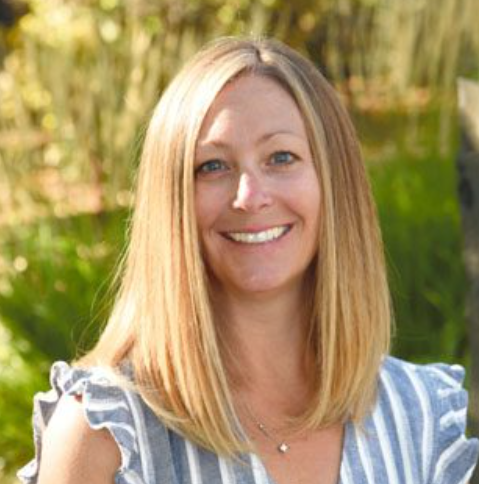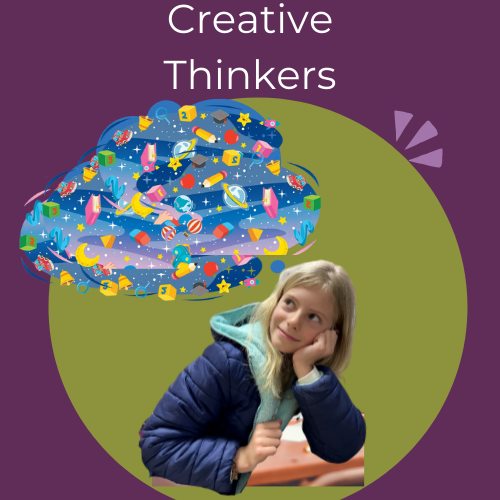Creativity requires a safe environment in which to play and take risks. At Bixby, it’s up to us to establish this kind of supportive classroom. Creativity is the most challenging thinking skill to acquire and the most sought-after. Creativity always starts with imagination, and history shows that many things we imagine are later actually created. Teachers who can model creative ways of thinking, playfully engage with content, and express their ideas, will create creative students. Here are some of the ways our Bixby teachers guide students to be creative thinkers in the classroom.
Allyson Rosenbloom: (3rd-5th Grade Math Teacher)
 “The math department read a book this summer called Building Thinking Classrooms in Mathematics. The book guides teachers to design classrooms filled with independent, creative problem-solvers rather than focusing on rote memorization and repetitive calculations. This has always been crucial to the philosophy of Bixby Math. The book outlines a potential structure for creating “Thinking Classrooms,” The math department has spent time this year trying it out with Bixby students. There are fourteen elements highlighted in the book, and all are worth exploring. Here is a small sampling:
“The math department read a book this summer called Building Thinking Classrooms in Mathematics. The book guides teachers to design classrooms filled with independent, creative problem-solvers rather than focusing on rote memorization and repetitive calculations. This has always been crucial to the philosophy of Bixby Math. The book outlines a potential structure for creating “Thinking Classrooms,” The math department has spent time this year trying it out with Bixby students. There are fourteen elements highlighted in the book, and all are worth exploring. Here is a small sampling:
- Students should have access to “vertical non-permanent surfaces” (such as dry erase boards and windows) so that we can see each other’s thinking, and we have the ability to erase easily.
- Classrooms should be “de-fronted,” meaning seats are scattered, not in rows, changing regularly, and the teacher should address students from various places in the room.
- Students are randomly paired (we draw cards in front of the students so they can tell the teacher didn’t decide on the partners). This totally randomized pairing inspires some of our most creative solutions to problems.
- The tasks we present to the students are highly engaging and sometimes linked directly to the curriculum. Becoming a creative thinker is an art, and we love to make space to grow those skills. “
Kim Haines: (3rd & 4th Grade Literacy)
 ” I firmly believe that creative thinking requires an environment filled with safety and choice. I strive to create a safe place for 3rd and 4th graders to improve and to experiment with their own writing. Feeling like they have some control or choice directly fuels their sense of safety. A great example of all of these pieces coming together is our recent poetry unit. Through Nina, I learned about an opportunity to submit student poetry for potential publication. I timed our unit to align with the contest deadlines, and we learned about and wrote lots of haiku in February. While traditional Japanese haiku centers on the natural world, I allowed students to choose their own subjects to increase personal investment. We wrote poems every day for at least a week’s worth of time. Some students wrote significantly more than the minimum, and many had a lot of fun playing with language, creating mood, and painting images with words. At the outset, I let students know that submitting to the contest was completely optional. I wanted this unit to include revision and editing; a class book of all students’ poetry provided an inclusive medium for publication independent from contest submission. Students chose which poems they wanted to revise, worked through the writing process, and typed their best drafts. Robert graciously agreed to tie his curricular plans to our project, and students are currently illustrating their poems with paintings they are making in Creative Design class. Once those are finished, we’ll share our poems with one another and assemble each grade’s book. And the icing on the cake? All of our 3rd and 4th graders who chose to submit poems learned this week that their writing was accepted and will be published later this year in a national digest of student poetry!”
” I firmly believe that creative thinking requires an environment filled with safety and choice. I strive to create a safe place for 3rd and 4th graders to improve and to experiment with their own writing. Feeling like they have some control or choice directly fuels their sense of safety. A great example of all of these pieces coming together is our recent poetry unit. Through Nina, I learned about an opportunity to submit student poetry for potential publication. I timed our unit to align with the contest deadlines, and we learned about and wrote lots of haiku in February. While traditional Japanese haiku centers on the natural world, I allowed students to choose their own subjects to increase personal investment. We wrote poems every day for at least a week’s worth of time. Some students wrote significantly more than the minimum, and many had a lot of fun playing with language, creating mood, and painting images with words. At the outset, I let students know that submitting to the contest was completely optional. I wanted this unit to include revision and editing; a class book of all students’ poetry provided an inclusive medium for publication independent from contest submission. Students chose which poems they wanted to revise, worked through the writing process, and typed their best drafts. Robert graciously agreed to tie his curricular plans to our project, and students are currently illustrating their poems with paintings they are making in Creative Design class. Once those are finished, we’ll share our poems with one another and assemble each grade’s book. And the icing on the cake? All of our 3rd and 4th graders who chose to submit poems learned this week that their writing was accepted and will be published later this year in a national digest of student poetry!”
Jill Beary: (Science Teacher)
 “Creativity powers Science, students engage and become more creative thinkers in a class by being presented with problem-solving. In Science, we have to use problem-solving in all areas but some main ways the students use this useful tool is when they:
“Creativity powers Science, students engage and become more creative thinkers in a class by being presented with problem-solving. In Science, we have to use problem-solving in all areas but some main ways the students use this useful tool is when they:
Use stop motion animation. This activity encourages students to find creativity from the start by building sets and characters for their stories. They then tell a story picture by picture and create ‘special effects’ to show objects flying.
Use Scratch or Scratch jr. to code scenes and stories. Students have to find creative ways to tell a story through coding and try different code blocks to achieve a particular effect.
Engineering Projects. In 4th and 5th-grade, students design and build their own inventions.
2nd and 3rd-grade students design and build hurricane rescue devices. 1st graders design and create water filters.
Using open-ended exploration. Students have to figure out how to get their ball around the room using ramps by building ramps. Also, with Little Bits Electrical Circuits by having to find ways to turn on lights, fans, buzzers, and motors through experimentation.”
Nicholas Morris: (1st Grade Social Studies and 5th Grade Math)
 “Now is a great time to see 2nd graders’ creative thinking on display! Their finished fantasy maps are up on the lower floor of Bixby (on the way to their cubbies). They did an amazing job in this project of expressing their creativity while also keeping the islands realistic. There are Pokémon portals and sea monsters and candy volcanos, but each map has land features, climates, and environments that are well thought out and (at least somewhat) logical.”
“Now is a great time to see 2nd graders’ creative thinking on display! Their finished fantasy maps are up on the lower floor of Bixby (on the way to their cubbies). They did an amazing job in this project of expressing their creativity while also keeping the islands realistic. There are Pokémon portals and sea monsters and candy volcanos, but each map has land features, climates, and environments that are well thought out and (at least somewhat) logical.”

Amanda, Alison, Anna, Jessica B, Elizabeth, Susanne : (Preschool) 
“To bring into being”. “This definition of the Latin creatus, from which the English word create derives, captures so beautifully what we see students doing through play in the Bixby preschool. Creative thinking in preschool is active. It is doing. Through dynamic exploration of all kinds, students bring themselves and their ideas into being. One of the most significant ways preschool teachers support creative thinking is purposeful language use. “I wonder…”, “tell me more,” and “why do you think…” are phrases one hears over and over in our classroom. Open-ended questions like these encourage deeper thinking and problem solving, two hallmarks of creativity. “
Lisa Manko & Izabela Zdunek : (Kindergarten)
 “Teaching Kindergarteners to be creative thinkers is usually an easy task- they’re already so creative! The students have endless opportunities to express their original ideas through art, science experiments, and writing assignments during the school year. A few weeks ago, the kindergarteners broke into groups of 3 and had the task of building a structure that could support the weight of a large marshmallow using only dry spaghetti noodles, tape, and string. Students had to think outside the box for their towers to support the marshmallow. Not only did each student come up with their own unique idea, but then they had to collaborate with their other group members to come up with just one building design. In the end, the kindergarteners successfully supported the marshmallows on top of their towers because of their collaboration and execution of creative ideas. “
“Teaching Kindergarteners to be creative thinkers is usually an easy task- they’re already so creative! The students have endless opportunities to express their original ideas through art, science experiments, and writing assignments during the school year. A few weeks ago, the kindergarteners broke into groups of 3 and had the task of building a structure that could support the weight of a large marshmallow using only dry spaghetti noodles, tape, and string. Students had to think outside the box for their towers to support the marshmallow. Not only did each student come up with their own unique idea, but then they had to collaborate with their other group members to come up with just one building design. In the end, the kindergarteners successfully supported the marshmallows on top of their towers because of their collaboration and execution of creative ideas. “




